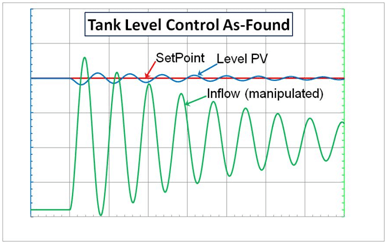We’ve shared many stories of process optimization situations and opportunities on this blog. I caught up with Emerson’s Mark Coughran, whom you may recall from many process optimization-related posts. Mark noted that upstream oil and gas producers also have opportunities to optimize their processes. What has held many back from capitalizing on these opportunities is that they do not have personnel trained in control system troubleshooting and optimization, or control system tools to make these tasks easy.
Mark shared several examples with me. Several offshore gas well platforms in Southeast Asia had troubles with control of receiver separators that caused interruptions to the gas production. The level controls responded poorly to slugs and this in turn caused unstable flows to downstream units. One of the process improvement and optimization consultants reduced the interruptions by applying Lambda Tuning in the distributed control system (DCS). The remaining limitation to the performance was the severely worn control valves, caused partly by being subjected by the control loop to continuous cycling and partly by sand in the produced fluid. Separators also often show opportunities to improve the control of overhead gas pressure by the same methods.
A second example was a new gas well platform in the Middle East that experienced level upsets and alarms on the test separators. This was very costly since it delayed well tests and well changeover. Using the trending tools of an onshore DeltaV workstation, the Emerson consultant worked with the operator to conduct simple tests of the loops to gather the process dynamics. With this data, it was easy to measure the dead band of the control valves and apply Lambda Tuning. This stabilized the levels, flows, and pressures.
A third example was an offshore oil platform that installed a small surge tank to supply water for injection. The complex piping included seven control valves and three variable speed drive (VSD) pumps. At startup, the tank experienced numerous low and high-level alarms. The Emerson consultant installed an override strategy, which required little maintenance. The system now “just runs” with no intervention by the operators.
A final example was a produced water treatment system in the Gulf of Mexico region that was difficult to operate due to large oscillations in the series of tanks. The operator tried to cope with this situation by running the four level controllers in manual mode. The Emerson optimization consultant diagnosed the loop limitations and applied Lambda Tuning to the PLC controller, which made the system easy to operate in the field. The consultant also documented means to further improve the control by correcting a problem in the control algorithm for the VSD pumps.

Level loop load step response with as-found controller tuning. The oscillatory inflow causes a cyclic disturbance to the upstream tank.

Level control with Lambda Tuning. Initially the level PV is returning to SP after a load disturbance. Then a step occurs on the load flow (outflow); note the inflow responds with a smooth increase and no oscillation.
These examples illustrate that improvement opportunities may have a variety of symptoms (oscillations, controllers in MANUAL, alarms, etc.) and a variety of root causes (inappropriate controller tuning, inadequate control strategy, control valve or VSD problems, etc). Mark and the team of optimization consultants have broad experience in oil & gas and many other industries and use tools that work on all types of feedback-based controllers.




